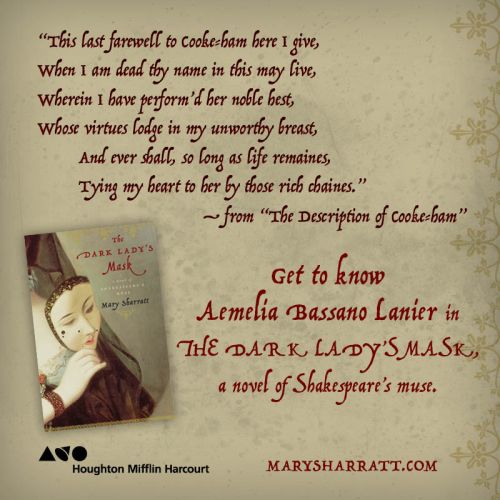
What do groundbreaking 17th century poet, Aemilia Bassano Lanier, and 20th century feminist icon, Virginia Woolf, have in common? A lot actually.
In her 1929 essay, “A Room of One’s Own,” Woolf imagines the tragedy of Shakespeare’s brilliant sister, Judith, barred from the grammar school because of her sex and forced to hide her writing from her family. To escape a forced marriage to a man she hates, she runs away to London to seek her fortune in the theatre, only to end up pregnant, abandoned, and destitute. Out of despair, she kills herself.
“It would have been impossible,” Woolf writes, “for any woman to have written the plays of Shakespeare in the age of Shakespeare.”
Woolf herself was writing both as a pioneering modernist author and as a woman struggling to break free of the sexist constraints that bound and muzzled women of her generation. Both Woolf, as a writer, and her sister, Vanessa Bell, as an artist, faced the harshest opposition and ridicule for daring, as women, to aspire to a life in the arts. Like Lily Briscoe, the pivotal character in Woolf’s novel, To the Lighthouse, Woolf and her sister were tortured by fears that their work was unworthy or would be forgotten or consigned to a dusty attic–simply by virtue of their sex.
If Woolf had only known about Aemilia Bassano Lanier, whose magnificent work had fallen into centuries-long obscurity for this very reason.
Shakespeare’s literary contemporary (and possibly his mistress and “Dark Lady”), Lanier prevailed against impossible odds to become England’s first professional woman poet. As a 17th century English woman, she faced considerable obstacles–the only acceptable literary genre for women was devotional Protestant verse. Lanier’s literary predecessors, Anne Locke and Mary Sidney, wrote poetic meditations on the Psalms.
But Lanier’s religious poetry is a radical tour de force. Published in 1611, Salve Deus Rex Judaeorum (Hail God, King of the Jews) is nothing short of a vindication of the rights of women couched in religious verse. Most significantly, Salve Deus is dedicated and addressed exclusively to women, and is prefaced by nine praise poems dedicated to the royal and aristocratic women whose patronage Lanier sought. She also included a dedication in praise of all women.
In short, Lanier wasn’t a protofeminist but a genuine feminist in every sense of the word.
Lanier’s greatest patron and dearest friend was Lady Margaret Clifford, Countess of Cumberland, who supported Lanier’s literary ambitions by giving her employment—she hired Lanier to tutor her young daughter, Lady Anne Clifford, and invited Lanier to live with her and her daughter in Cookham, a rambling medieval manor. Lanier’s poetic ode to the idyll she shared with Margaret and Anne is immortalized in her poem, “The Description of Cooke-ham,” which might be the first country house poem in the English language.


The poem celebrates a woman-centered household whose residents devote their days to literature and music, sisterhood and friendship, and a shared reverence for the beauty of nature. This trio of women didn’t just have a room of their own but an entire manor and its grounds. However, this idyll was short-lived and came to an abrupt end when Margaret’s estranged husband died and disinherited Anne, his only child, because of her sex. Instead he left his vast properties to a male relative.
But back to Virginia Woolf. Anne Clifford, who married Richard Sackville, Earl of Dorset, is a direct ancestor of Vita Sackville-West, Virginia Woolf’s muse and lover. As a playful homage to Vita, Woolf wrote Orlando, a daring, gender-bending novel inspired by Anne Clifford’s long struggle to gain back her property after her disinheritance. Clifford, who survived two unhappy marriages, eventually triumphed to be one of the most powerful female landowners in Northern England.

Did Virginia Woolf’s 20th century feminism, then, have its roots in Aemilia Bassano Lanier and Anne Clifford’s passionate assertion of women’s rights? Even if Woolf never discovered Lanier’s work, even if she couldn’t imagine any female contemporary of Shakespeare ever making her mark, these women had already blazed a trail for her.
Our great tragedy is how women’s history and our female lineages keep being obscured, lost, and trivialized. We must keep writing women back into history, for we stand on the shoulders of all the women who have gone before us. Feminism is nothing new. Women’s struggle to assert their human rights and live to their full potential has happened continually through the ages, with periods of progress often followed by backlash and oppression. Let us never forget our debt to our foremothers.

Mary Sharratt is on a mission to write women back into history. Her acclaimed novel, The Dark Lady’s Mask: A Novel of Shakespeare’s Muse, drawn from the life Aemilia Bassano Lanier, is now in paperback. She is also the author of Illuminations: A Novel of Hildegard von Bingen, inspired by one of the most creative women of all time. Visit her website.


It is so important to remember the women who made our lives possible.
“If I had not suffered, you wouldn’t be wearin’ those jeans…” From Old Time Woman by Holly Near
LikeLike
Yes! It’s scary how quickly the younger generation can forget.
LikeLike
I teach high school and work quite hard at making sure students learn about history and how women suffered, had to use men’s names to get anything published, etc. They seem shocked and yet old stereotypical ideas and attitudes keep cropping up. The struggle seems endless.
LikeLike
Reblogged this on KITTY NOLAN and commented:
‘Let us never forget our debt to our foremothers.’
LikeLike
Thanks so much for reblogging, Kitty!
LikeLiked by 1 person
“Our great tragedy is how women’s history and our female lineages keep being obscured, lost, and trivialized. We must keep writing women back into history, for we stand on the shoulders of all the women who have gone before us. ”
Thank you!
LikeLiked by 1 person
Thanks for reading, Sara!
LikeLike
Mary Sidney, the Countess of Pembroke and Sir Phillip Sidney’s sister, wrote the first play in English about Antony and Cleopatra in 1592. It’s one of the plays I studied for my Ph.D. dissertation. Cleopatra, historically a strong and independent queen, was the subject of a dozen plays in English. But she wasn’t what we might call a feminist.
I’m wondering if the new series of Shakespeare books being published by the Hogarth Press (created by Virginia and Leonard Woolf) has any kind of (however indirect) connection to Bassano-Lanier and Clifford. They’re novels more or less inspired by Shakespeare’s plays. I thought the novel based on The Merchant of Venice was awful, but Margaret Atwood’s Hag-Seed, a retelling of The Tempest set in a prison (think: Shakespeare Behind Bars) is splendid and recommend it to you all.
Mary, I love your novels. Write some more!
LikeLike
Mary Sidney’s Antony and Cleopatra play features in THE DARK LADY’S MASK! She was an incredible polymath and also a patron of other writers.
I wonder, too, about the Hogarth Shakespeare series exploring the Bassano Lanier connection. I must say I haven’t read any of them.
Thanks so much for reading, Barbara!! Your commentary is always so insightful.
LikeLike
“Our great tragedy is how women’s history and our female lineages keep being obscured, lost, and trivialized.”
So true! I had despaired that my daughters’ generation was complacent because of the work that my generation had done. But NO MORE. They’ve awakened. And that’s why posts like yours are so important. Please keep reminding women everywhere. And thank you for writing, Mary.
LikeLike
Thank you, Lorraine! I think Trump’s horrific presidency was a wake call for many people. We can no longer take any of our rights for granted.
LikeLike
You are so right Mary Sharratt where you say: “Women’s struggle to assert their human rights and live to their full potential has happened continually through the ages.”
There’s a poem by Emily Dickinson, written back in 1858, where she fails, but she refuses to give up, and then takes herself back again, and carries on. She says:
Adrift! A little boat adrift!
And night is coming down!
Will no one guide a little boat
Unto the nearest town?
So Sailors say — on yesterday —
Just as the dusk was brown
One little boat gave up its strife
And gurgled down and down.
So angels say — on yesterday —
Just as the dawn was red
One little boat — o’erspent with gales —
Retrimmed its masts — redecked its sails —
And shot — exultant on!
LikeLike
What a beautiful poem! Thank you for sharing that, Sarah.
LikeLike
Yes! Thank you for reminding us that “We must keep writing women back into history, for we stand on the shoulders of all the women who have gone before us.” and for continuing to do so yourself. I’m so excited that you have a new book out to read. Can’t wait!
LikeLike
Thank you, Judith!
LikeLike
Reblogged this on poetry from the frontera and commented:
Inspiring and well written by Mary Sharrat
LikeLike
Thanks so much for reblogging, Donna!
LikeLiked by 1 person
I had never heard about Judith Shakespeare before. What a tragic story. I feel that’s something that schools aught to teach alongside his works.
LikeLike
“Judith Shakespeare,” as depicted above, was Virginia Woolf’s imagining of what would have happened if William Shakespeare had an equally gifted sister. This is from her essay, “A Room of One’s Own.” It’s not the historical description of what really happened. It’s Virginia Woolf’s imaginative speculation.
William Shakespeare did have a sister named Judith, but it seemed she married and had children and lived a mainstream life.
LikeLike
Ah, I wasn’t clear on that from the original text. Thank you for the clarification.
LikeLike
And thanks so much for your comment! :)
LikeLike